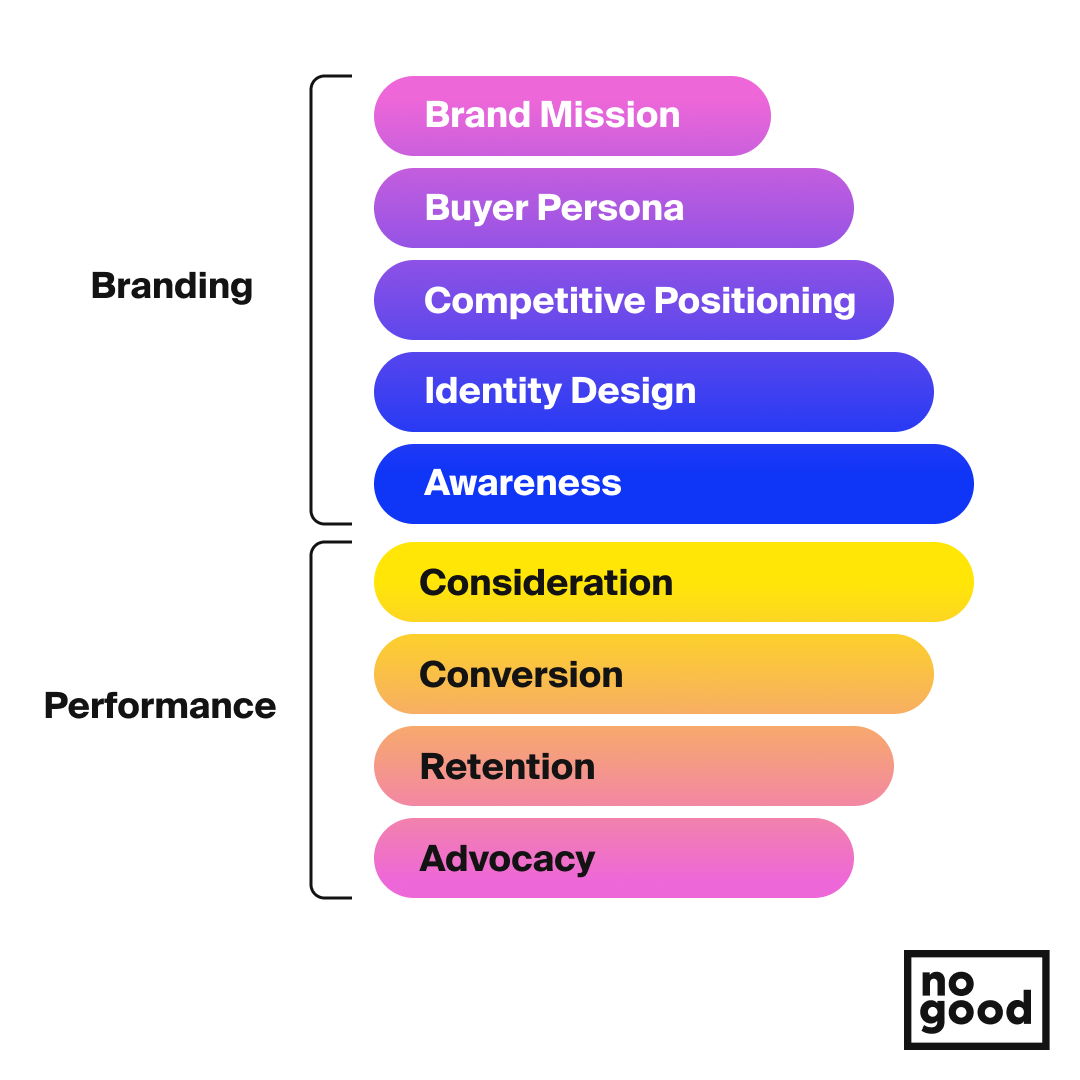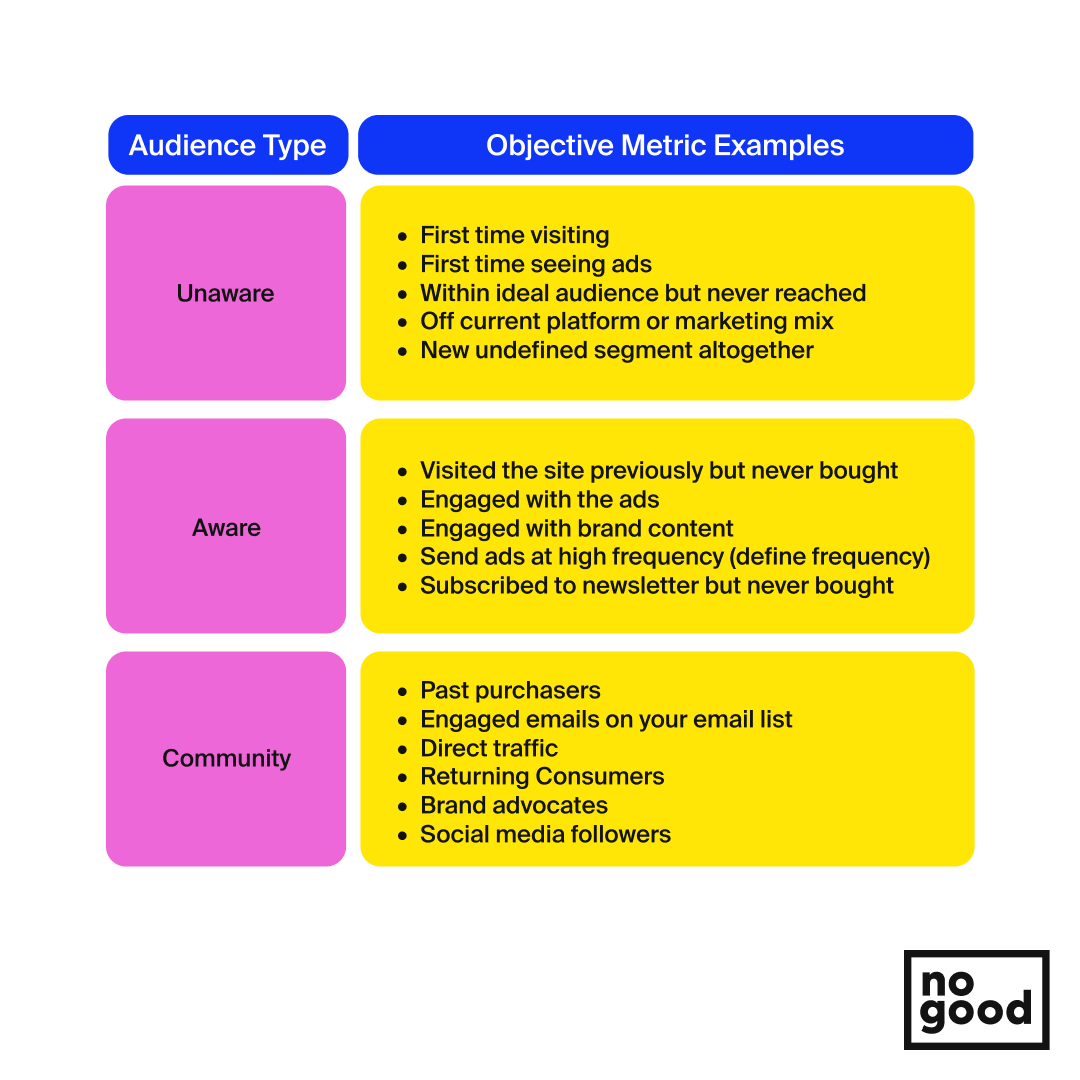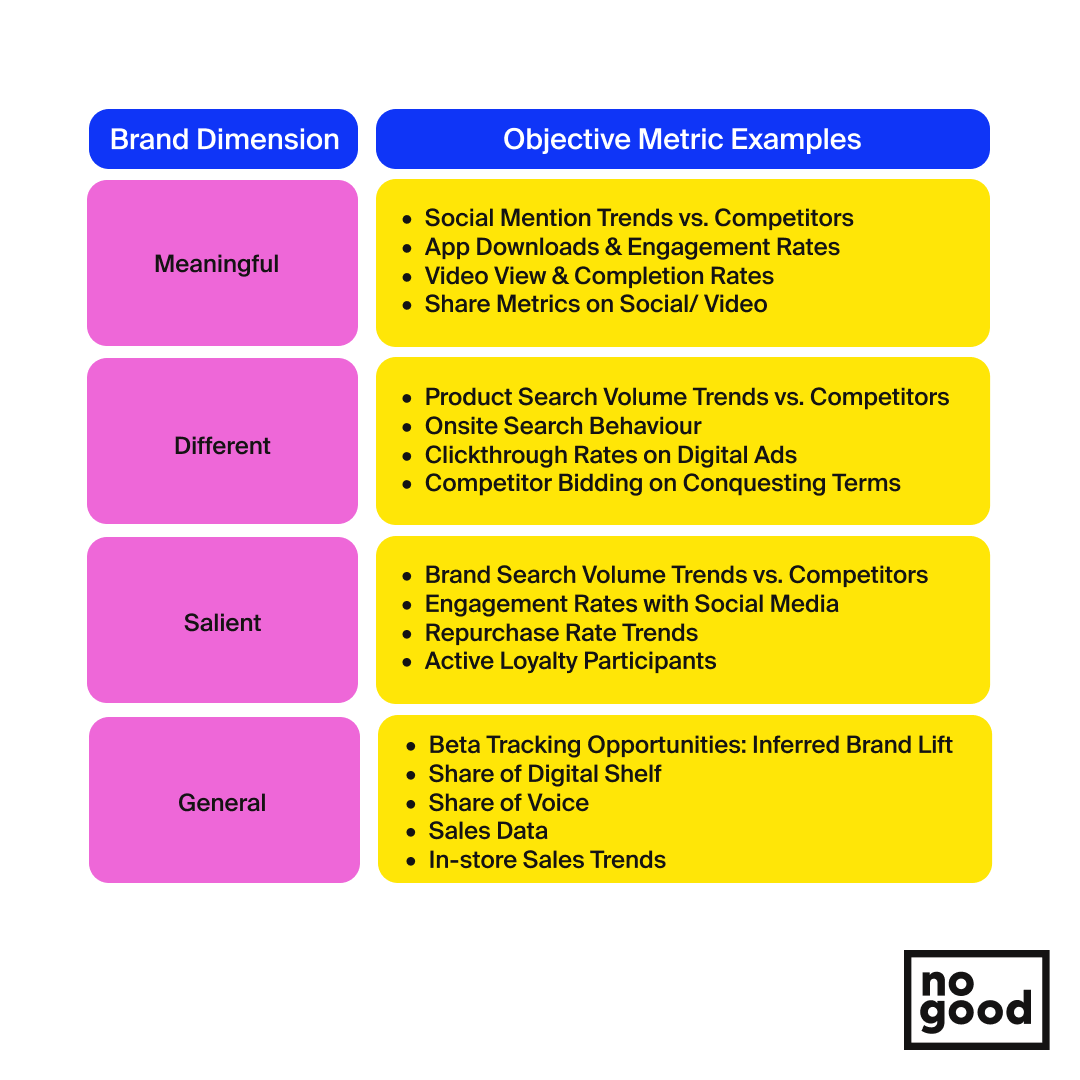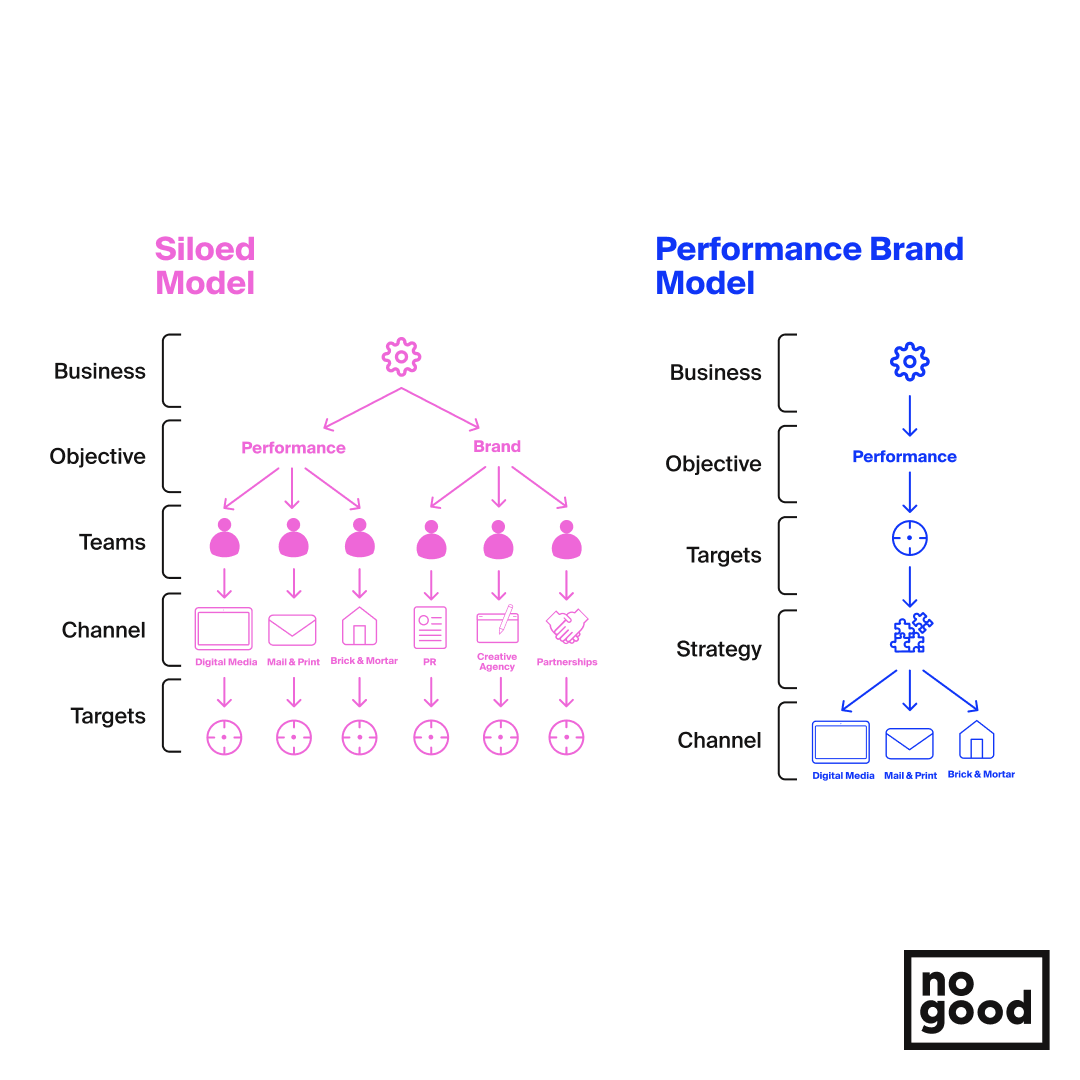Data versus creativity, performance versus branding, science versus art — these were all once considered polar opposites within the marketing world, but that is no longer true.
Traditionally (and rather archaically), branding and performance have existed as completely different disciplines. Brand marketing focuses on the art of telling a story through a brand’s visuals, values, and personality, while performance marketing focuses more on leveraging concrete data to generate measurable conversions and revenue. Essentially, brand marketing is people-focused and value-oriented, while performance marketing is data-focused and profit-oriented. That opposition, or more specifically the common misconception that such opposition exists, is where the problem lies.
Performance branding can be defined as the intersection of brand and performance marketing, where creativity is rooted in data and performance is fueled by brand equity. Performance branding leverages the unique strengths of branding and performance marketing and combines the two once-opposite disciplines to craft big-picture strategies that drive both long-term brand recall and measurable conversion results.
What is Performance Branding?
Here at NoGood, we see performance branding as a strategy that leverages a symbiotic relationship between the worlds of branding and performance marketing to tell purpose-driven brand stories, one metric at a time. We believe in debunking the common notion that creative and analytics don’t mix, and we apply storytelling fundamentals with a data-backed performance funnel to maximize revenue potential and increase brand LTV.

Businesses miss significant opportunities when they don’t consider how departments work together, especially when there is a lack of communication between different teams in terms of overall goals and strategies. Focusing solely on branding without paying attention to metrics and KPIs creates a waste of creative resources that could otherwise be improved and refined by data. Similarly, pursuing profit without understanding the why behind your conversions forgoes your opportunity to truly get to know your customers and build a loyal community. That’s why more and more businesses are recognizing the value of taking a more multidisciplinary approach to their marketing strategies, and are beginning to pursue a new version of quality-driven profitability for a higher level of sustainable growth.
From creating content with clear KPIs in mind to analyzing audience data to refine storytelling approaches, performance branding is all about creating a cohesive, unified end-to-end experience for smarter learnings and more consistent impact.
Why Now?
Performance branding as a timely response to cultural, behavioral, and technological shifts.
The marketing landscape is changing — and agencies should evolve their offerings to adapt to that change. The increasing amount of potential brand touchpoints calls for a greater consumer need for authenticity, the introduction of new performance metrics demands more experimentation and data-driven processes, and the iOS 14 update has fueled a larger shift towards more ethical tracking. And this is only the beginning.
Here are some of the key changes driving the shift towards a newer performance branding model:
1. There is no longer a need to choose one discipline over the other — you can (and should) have it all
By mixing brand and performance activities, marketers make a stronger impact and improve measurability. They use brand marketing to establish their personality and point of view over time, then add performance marketing to take their offer directly to buyers — all backed by hard data. Brands now pay equal attention to how they tell their story and the ways they target and measure their audience response. It’s no longer a choice between brand or performance marketing — it’s brand + performance marketing, working in harmony.
2. Consumers value and prioritize authenticity in brand communications
According to a study conducted with 56,000 internet users surveyed from across 81 countries, 96% of consumers do not trust influencers when it comes to the information they present on social media. It is becoming increasingly clear to brands and businesses that the age of manicured perfection is over, paving the way for a greater need for authenticity in all channels of communication. Being too aspirational is repellent now, and the greatest asset that brands and influencers can have is trust — a scarcity that few are able to foster. This consumer desire for authenticity is reflected in the rise of UGC and creator partnerships, where brands are tapping into the creator economy to generate top-of-funnel awareness that ties directly to a brand’s purpose and values. Since performance branding leverages audience data as a way to continuously craft and refines a brand’s DNA, it ensures that brand messaging is driven by a genuine desire to provide value to the consumer rather than mere profit or conversion metrics.
3. The iOS 14 update will impact the amount of data available to marketers
Apple’s iOS 14 update is expected to limit data available from app developers as the old opt-out approach is now switching to an opt-in approach. This attention to consumer data acquisition will most likely lead consumers to avoid those tracking capabilities and diminish the information available to marketers. The need for thorough and multi-channel data compilations for individual consumers will be glaringly obvious as you will need to capture user information whenever possible. That very need will reflect the importance of performance branding to solve the limitations on data and consumer behaviors, as separate teams targeting incomplete user profiles individually will only complicate the issue further. Brands will need to diversify their approaches on different channels, and leverage audience data to determine what message works best for which channel, as well as what creative conveys their brand message most effectively. By applying brand creatives to experimentation frameworks across different channels and audience segments, brands will be able to capture the data needed for performance optimizations and lead with value for their customers.
A Self-Sustaining Growth Loop
Performance branding is a way to achieve sustainable, long-term growth over time.
The performance branding approach evolves the brand into a self-sustaining model that fuels growth through what’s called a “growth loop”. Growth loops are sustainable processes where the investments you make generate output that can then be reinvested without having to draw on additional resources. The key to activating a growth loop is essentially to create a brand that has a solid foundation in both its strategy and design frameworks.
A brand activates growth loops through the relationships that it builds with its audience and the reputation it acquires over time. The emotional connections customers build with their favorite brands lead to loyalty, customer retention, and — surprise! — advocacy for your brand. People who believe in your story and share your values, who have had a positive experience with your brand, will keep coming back. They may even recommend the brand to others, hence stimulating a self-multiplying loop of continuous growth.

Consider Klarna, for example. The brand started with a promise to create an inspiring, “smooth” shopping experience, from browsing to checkout and monthly payments. Meanwhile, the majority of its competitors in the “buy now, pay later” space focused on (and limited themselves to) making the checkout and payment experience seamless. Klarna didn’t just make a promise; the brand maintained consistency across multiple touchpoints – from fun, pink, emotion-driven ads to creating a one-button shopping experience to an app that lets customers browse products they might be interested in.
If a shopper sees Klarna’s logo as a payment method while browsing, they are very likely to use it — based on an existing positive experience, brand recall from promotions, or positive feedback they have received from other users.
The growth loop is just one of the many examples of how brand initiatives can lead to performance outcomes. The outdated notion that the value of a brand is immeasurable or too amorphous should not deter you from investing in your brand, as when used correctly and consistently it can provide the fuel for long-term and increasing growth.
Branding as a Foundation for Performance
Defining brand as the single source of truth containing the core building blocks to a strong foundation for future performance and optimizations.
Think of performance branding as a lens through which you view your business — a singular source of truth that you will always refer to in order to solve problems, work through setbacks, and find the answers to most of your questions. The brand is more than just a visual identity or a logo — it’s an objective approach that relies on 3 core elements: the design, the positioning, and the growth. These 3 key elements form the overarching brand system that will strategically guide all decisions in the growth and scaling process.

The Positioning
Your brand’s positioning framework is essentially your brand’s unique value proposition, identity, and story. It determines your brand’s positioning in the marketplace, its unique differentiators, and how customers perceive your brand. This strategy relies on extensive research — from customer development to competitor analysis — to prove the concept and with the goal of identifying your unique niche for success. In this system, you will also identify your unique tagline that gets to the heart of your value proposition.
The key deliverables in this phase of strategic planning are your brand architecture, manifesto, unique tagline, and brand map — all of which should be informed by your audience, product landscape, and competitor research so that you are providing the right value to the right customers.
The Design System
The next pillar is your design system: the visual language that helps you convey the identity you outlined in the positioning framework through aesthetic elements. The design system gives you the ability to effectively and quickly tell your brand’s unique story while remaining consistent across multiple channels and touchpoints. From logo to color scheme to font, the design system makes the positioning you develop in the first phase tangible. In other words, it’s your look and feel. The brand design system is important for performance because it ensures that your consumers receive a cohesive end-to-end experience, resulting in higher recognition, clicks, and conversions.
The Growth Framework
The final element of branding is the growth framework, which includes the scaling strategy and metrics that allow you to experiment quickly as you chart a path for growing your brand. This is where you’ll prove or disprove hypotheses, test visuals and messaging, measure results against your KPIs, and reach your revenue goals — all under the unified umbrella of your brand. The growth framework should be developed in tandem with, and not against, your brand design system so that you build a solid foundation that remains scalable and evergreen throughout the lifecycle of your brand.
Taking the Full Funnel Approach
Shifting away from siloed funnel stage approaches to tackle TOF, MOF, and BOF strategies as a cohesive whole.
Traditional branding has long been concerned with brand recall, recognition, and reputation, but these top-of-funnel initiatives don’t always trickle down to the middle-of-funnel or bottom-of-funnel optimizations to drive people through the entire funnel. On the other hand, performance marketing is very focused on traction on bottom-of-funnel and middle-of-funnel metrics and lacks consideration of the equally important top-of-funnel brand awareness.
The advantage of performance branding is that it shifts away from former approaches that didn’t take into consideration the entire funnel (performance) or focused too heavily on the top of the funnel (branding). Instead, performance branding takes a full-funnel approach that considers the nuances of every stage of the buyer’s journey. The top-of-funnel buyer’s persona is used to create custom landing pages for audience segments, and the bottom-of-funnel conversion strategies are reinforced by strong and consistent brand identity design. Ultimately, performance branding recognizes the importance of seeing the big picture, so that no funnel stage is ever optimized in isolation.

Implementing the Performance Branding Model
Fundamental steps to take to integrate performance branding into your marketing strategies.
Recognizing the need for a change in marketing strategies does not mean there is a simple way to approach that shift. However, there are important focuses that can help guide any brand into this new approach, all based on those who have already taken advantage of this powerful strategy and the core values of brand and performance today.
Here’s your roadmap:

Step 1: Create your brand strategy
Your brand strategy should include competitive mapping, an ‘onliness statement’, customer personas, and unique value propositions, which will all culminate in a holistic brand DNA and manifesto story. The brand strategy is essentially the promise you make to your customers and the identifiable audience need that you deliver.
Step 2: Create the design system that communicates your brand strategy
When it comes to color schemes, typography, and visual elements, your design system should communicate your brand story and DNA in a manner that resonates with your customer persona. Every detail and every decision in the design process can and should be informed by audience data and competitive research so that your brand elements can drive growth and performance in addition to visual engagement.
Step 3: Infuse macro and micro experimentation based on the above
Experimentation is at the core of the performance branding approach; it allows you to derive learnings directly from your target audience and pushes you to continuously refine and improve your brand strategy and design system. Experimentation ideally comes in the form of both macro and micro experiments that work in tandem with each other to provide a strategic and tactical view of your brand’s performance. Macro experimentation can test messaging strategies, customer types, and channel options, while micro experimentation works with visual cues, delivery style, typography, color combinations, attention triggers, and micro-copy.
Step 4: Rinse and Repeat
The beauty of the performance branding roadmap is that it’s never linear — it’s an ever-growing loop of continuous refinement that will push your brand towards long-term success. To fully implement the performance branding model, create an ongoing iterative process of macro and micro experiments, draw learnings, and continue to iterate through the combination of brand and performance.
Performance Branding: Do’s and Don’ts
What to watch out for when implementing the performance branding model.
Do: Take an agile and informed approach
Personalization is unlikely to work if it is unscientific. Top DTC brands spin up multiple iterations of creative concepts and brand stories. They map each to a particular media or point in the consumer’s buying journey, then use data to refine their approach.
Do: Foster belonging through branding
Look for ways to share and reuse the original content produced by customers and key influencers. Supporting these grassroots storytellers boosts authenticity and builds trust that’s invaluable to growing a brand.
How do you measure brand when, traditionally, people say it is too amorphous to measure? Break down the audience into 3 main buckets.

Don’t: overlook the operational details
The flip side to the benefits of data-driven marketing is an increase in accountability. Take the time to optimize all the touchpoints that impact the consumer experience before hitting “launch” on the next performance campaign.
Do: Recognize the value of centralized and accessible data
More data points inform adjustments to creative, messaging, and landing pages to best align every part of an interaction with what we know about the customer. That data might include:
- Previous purchases
- Areas of interest
- Location
- Life Events
Set aside a healthy portion of each year’s budget (as much as 30%) as “protected spend.” These funds have less strenuous MROI goals, making them ideal to try new tactics, channels, and audiences.
Do: Develop identity graphs
Cross-channel identities complicate marketing. Individual customers can switch between devices, locations, and users, not to mention marketers often are using several distinct toolsets to evaluate separate channels. Compiling that data into one single user identity is invaluable to developing people-based targeting, measurement, and personalization so that brands avoid ad repetition and over-targeting due to fragmented customer views. The solution is an identity graph (or ID graph), which is one database holding a collection of user-level data combined with identifiers such as digital cookies, physical addresses, email accounts, and mobile phone numbers. Those common distinguishing identifiers work together to draw a complete picture of a user’s identity across platforms and channels. This type of database enables advertisers to better understand consumer preferences and habits along their entire decision journey and across channels and devices.
Do: Build out your customer data platform (CDP)
Personalization is best used as part of a long-term strategy. Strong data starts with building out a CDP that incorporates data from internal sources, external partners, and third parties in a compliant fashion and at the level of individual customers and provides links to execution platforms. The CDP needs to be developed and managed by a trusted team that can oversee the integrity of the data as a single source of truth for the business. Thanks to agile insights applications, questionnaires can now be customized, and individual responses can be matched with an existing individual-level database. Increasingly, the impact of traditional advertising can be measured and optimized at the individual or household level.

A reliable marketing attribution model on top of a customer relationship management (CRM) system or a marketing database can tie all marketing activities back to individual users and purchases. A solid content team with a foot in culture and community can be a strong pulse from a qualitative and quantitative perspective on what should be the next top-funnel brand campaign about and what really matters for the brand community.

Brand marketing has its own channels as well, but measuring the results is often hard or even “vague.” By using the advancements of performance tracking and brand tracking data, brands can now analyze better and minimize the risks. Brands are able to easily test different messages, get fast and measurable results on how users respond, and foster engagement with their content.
Conclusion
Attitudes and behaviors have changed — and not necessarily in an immediately apparent way. What that really means for marketers is that the ability to be flexible, adopt a more nimble approach, be fluid with investments based on objective, actionable data, and adapt marketing strategies to new behaviors will be more important than ever. Performance branding ensures there is consistency across campaigns and communications for an entire business. That’s why performance branding is the perfect fit for our new normal (and any normal that comes after that).







